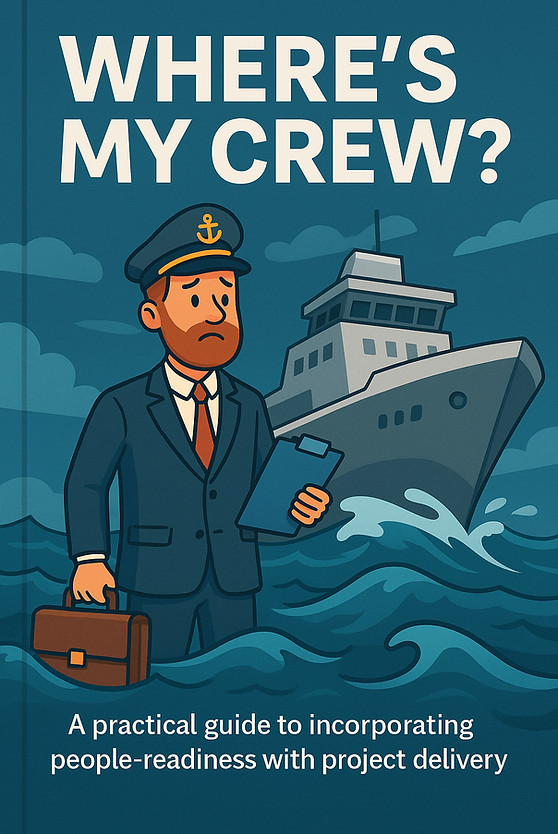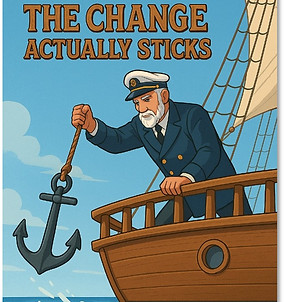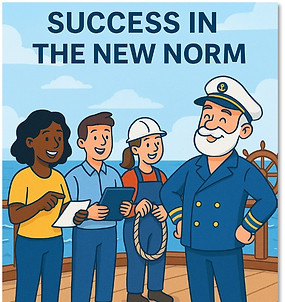

The project is officially complete. The timeline was tight, but the team hit every milestone. The budget held firm, the handoff documents are thorough, and the solution is live. From the outside, everything looks like a success.
And yet, just days after launch, confusion has set in. Work has slowed down, users stumble through new tools they don’t understand, and leaders are hesitant to enforce processes they didn’t help shape. The organization, despite having a brand-new ship, doesn’t seem to know how to sail it.
That’s when one brave captain says it. “Where’s my crew?”
If we want our projects to create lasting value, then we need to stop acting surprised when a beautifully built ship fails to navigate.
It’s not a delivery problem. It’s a people problem.

There are projects that check every box. The system works. The new process is clean. The budget’s in line. Everyone who touched it is technically “done.” But a few weeks later, the people who were supposed to use it, just don’t. They go back to old habits. They skip the new steps. Or worse, they find workarounds and pretend they’re on board.
Building the thing is only half the job. Getting people to use it is the other half, and most projects don’t plan for the people half at all.

OCM is not a motivational poster. It’s not a one-time training session. It’s not just a communication plan. It’s a thoughtful, structured way to prepare people for what’s coming, support them while they make the shift, and help them stick with it long enough that the change works the way it was intended.
If project management is about building the ship, OCM is about getting the crew trained, equipped, and confident to sail it.

It’s not enough to manage the technical side of change. You’ve got to manage the people side, too. And the sooner you bring those two things together, the better chance you have of delivering something that works long-term.
It means project managers and change managers work together from the start. It means building one timeline - not two. It means aligning on the understanding that success is not just “Is it done?” but “Is it used and useful?”

The initiation phase of a project is where everything starts taking shape. It's when the sponsor says, “Let’s do this,” and the team starts defining what “this” actually is. But too often, what’s getting scoped, budgeted, and scheduled doesn’t fully consider who it will affect, and how those people will need to be brought along.
Don’t skip the most important part of any journey: getting your crew on board from the beginning.

If initiation is where a project is born, planning is where it gets legs. Teams are formed, tasks get scoped, timelines take shape, and everyone starts mapping out how to get from Point A to Point B. This is usually where the project manager shines by putting structure around the chaos.
But here’s what most people miss: this is also the most powerful moment to bake people-readiness into the work rather than try to bolt it on later.

This is where the rubber hits the road. Tasks are flying. Meetings are nonstop. People are building, testing, reviewing, fixing, and updating to move the project toward go-live. It’s easy to get so deep in the delivery that you forget what the change will feel like for the people on the receiving end.
That is how resistance builds quietly behind the scenes. You don’t see it on the dashboard, but you’ll feel it when adoption tanks. Execution isn’t just about finishing deliverables. It’s about preparing people to thrive in the new norm.

In project management, this phase is about tracking progress against the plan. Are we hitting our milestones? Are we staying on budget? Are issues getting resolved?
In OCM, this phase is about tracking adoption and behavior change. Are people using the new system? Are they following the new process? Are they getting stuck or going around it altogether?
Because just launching something doesn’t mean it’s working. A good dashboard might say “green,” but hallway conversations and feedback forms might be flashing “red.”

Most project teams breathe a sigh of relief when they hit go-live. You check the final boxes, hold a wrap-up meeting, archive the files, and move on to the next thing. But here’s the truth: Just because the project is done doesn’t mean the change is finished.
Too many projects stop at delivery. The system is live, the communications have gone out, and training sessions have been completed. Technically, everything is finished. But then reality sets in.
People start slipping back into old habits, leaders go quiet, metrics stall (if there are any), and the energy around the change fades – all because the change is not being reinforced.

Sustainment is the difference between a project that makes a short-term splash and one that delivers real, lasting value. It’s about making the change stick not just for this month, but for good.
Too often, this part is overlooked. The team disbands, the sponsor shifts focus, and the support structure fades away. But change isn’t permanent just because it launched. It becomes permanent when it’s reinforced, normalized, and woven into how people work.